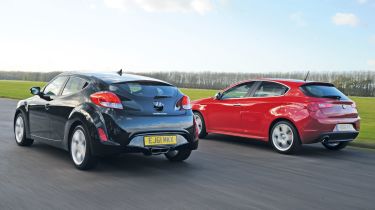Hyundai Veloster vs Alfa Romeo Giulietta
Four doors or five? We see which car success fully blends practicality and driving fun
We've already seen how the Veloster stacks up against a conventional coupe, but how does it measure up to a proper five-door hatchback? With the kind of svelte body styling that would turn plenty of coupe drivers green with envy, the Giulietta should provide the perfect test.
Alfa Romeo has a long, illustrious history and serious badge appeal, so if the Veloster wins here it will show just how far Hyundai has come in recent years. Styling-wise it’s a case of a classical Italian beauty versus the Veloster’s quirky modernism, but both cars feature some attractive detailing. Yet despite lacking a coupe profile, it’s the Alfa that gets more looks out on the road – particularly with the optional £490 red paint.
However, it’s worth noting that the car in our shots is a higher-spec Veloce model and not the Lusso we tested, which does without those lovely 18-inch wheels, contrasting grey door mirrors and side skirts. For most, choosing between the two will come down to individual tastes, but step inside and it’s an altogether different story.
The Alfa’s dash layout is appealing enough, with dials inspired by those in the 8C Competizione supercar. However, the materials grow harder and cheaper as you move away from the steering wheel. For a relatively new car the Giulietta feels quite dated, too, with cheap digital displays and small, fiddly stereo controls.
Used - available now

2019 Ford
Fiesta Vignale
44,100 milesManualPetrol1.0L
Cash £10,500
2022 Volkswagen
ID.3
33,043 milesAutomaticElectric
Cash £13,500
2023 Audi
e-tron
50,934 milesAutomaticElectric
Cash £18,900
2022 Dacia
Duster
49,300 milesManualPetrol1.0L
Cash £11,100The pedals are a particular issue as they’re poorly spaced and slippery, making it tricky and uncomfortable to drive the Giulietta over long distances. The Alfa’s poor ergonomics are a particular letdown when stacked against the cheaper Hyundai’s. With its bright touchscreen display, excellent driving position and robust materials, the Veloster feels like the higher quality product in this pairing.
However, the classy interior will count for nothing if the Veloster can’t compete with the Alfa for space. It might be the smaller car, but Hyundai is using the extra door as a selling point over regular coupes, so this has to give the Veloster a tangible advantage when it comes to practicality.
On paper, the Giulietta’s larger dimensions and 350-litre boot easily beat the Hyundai’s more modest 320-litre capacity. But slide into one of the Alfa’s rear seats and there’s a surprising lack of passenger space. And while it boasts easier access thanks to wider rear doors, both knee and headroom are very tight.
Rear headroom is also an issue in the Veloster but its longer wheelbase ensures there’s decent legroom. However, it’s a strict four-seater. The opening of the single rear door is narrow and compromised by the car’s low roofline, but at least the single rear door is on the pavement side, so your passengers aren’t forced to step into the road.
The Veloster felt light on its feet compared with the Astra, but the Giulietta should provide another stern dynamic test thanks to its powerful and efficient 1.4-litre MultiAir engine. While it is 200cc smaller than the Hyundai’s unit, with a turbo boosting power to 170bhp and 250Nm of torque, it easily outguns the Veloster at the track. It sounds great, too, and its linear power delivery means it’s easily the Giulietta’s best feature.
It’s the polar opposite of the Veloster’s breathless and muted engine, and the in-gear track times tell their own story. The Veloster took five seconds longer then the Alfa to surge from 50-70mph in fifth gear – but it’s worth noting that a 120bhp version of the Giulietta is available, which is £1,500 closer to the Veloster’s low price.
The Alfa’s more sophisticated suspension set-up should give it the edge on twisty roads, yet despite meatier steering feel it doesn’t offer any more feedback than the Veloster. The DNA system doesn’t help matters, either. It adjusts the throttle, steering and stability control to suit each of the three driving modes – but none of them provides a satisfying experience.
It’s the Alfa’s brakes that are the biggest disappointment, though. There is several inches of dead travel before they start to bite, so they feel jerky and unpleasant. It’s no surprise that the Hyundai stopped more quickly from 70mph.
The Giulietta can’t match the Veloster for cruising refinement, either, and it trailed at the pumps too, returning 6.4mpg less on the day. The Giulietta falls short as a family hatch and a driver’ car, so the Veloster is odds-on for a win.







